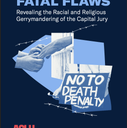
An African-American man sentenced to death in Hamilton County, Ohio in 1999 for the murder of a white man is seeking to overturn his conviction and death sentence based on evidence from a recently published study that he was more than five times more likely to be sentenced to death because of his race and the race of the victim in his case.
On September 3, 2021, citing statistical evidence from a study that found that the races of the defendant and the victim have significantly influenced the administration of the death penalty in Hamilton County, Walter Raglin filed a motion for a new trial arguing that his conviction and death sentence were the improper product of racial discrimination.
The study, authored by Professors Catherine M. Grosso and Barbara O’Brien at the Michigan State University College of Law and Assistant Federal Public Defender Julie C. Roberts of the Capital Habeas Unit of the Federal Public Defender for the Southern District of Ohio, and published last year in the Columbia Human Rights Law Review, reviewed the treatment of aggravated murder cases in Hamilton County over the quarter century between January 1992 through August 2017. The study found statistically significant evidence of discrimination in charging practices and sentencing outcomes based on both the race of the defendant and the race of the victim.
The authors of the study examined 599 cases in which Hamilton County prosecutors charged defendants with aggravated murder, attempting to ascertain whether race played a significant role in the administration of the death penalty. “Hamilton County, Ohio, lies technically just north of the South, but it is close,” the authors wrote. “Its history reflects the emblematic segregation and overt racism associated with the South. … It also remains in the top 2% of counties producing a majority of executions nationally.”
Also considering Hamilton County’s history of racial discrimination, lynchings, and racial segregation, the researchers concluded that “[t]he local practice and history, bolstered by the statistical analysis, makes a strong case that race has influenced the administration of capital punishment” in the county.
In a statement to the media in 2020, Hamilton County’s long-time Prosecuting Attorney Joe Deters said “I set the bar higher than the law requires, and only the absolute worst cases are considered for death penalty prosecution.” However, Raglin’s motion noted, the Columbia Human Rights study found a strong race-of-victim preference in county prosecutors’ decisions to seek the death penalty. The study found that, in cases with at least one white victim, the odds that a defendant would be capitally charged were 4.54 times greater than in a similarly situated case with no white victims. It further found that a black defendant who was charged with the aggravated murder of at least one white victim “faced odds of receiving a death sentence that were 3.79 times those of all other similarly situated defendants.” When the researchers then examined the subset of those cases in which prosecutors sought the death penalty, they found that “a black defendant with at least one white victim faced odds of receiving a death sentence that were 5.33 higher than all other cases.”
In a September 2020 commentary in the Cincinnati Enquirer after the study was published, Tyra Patterson, Community Outreach Strategy Specialist at the Ohio Justice & Policy Center in Cincinnati, wrote, “The death penalty lays bare which lives Ohio values most: We are more likely to seek death for defendants identified as Black, Lantinx or ‘other,’ and authorities are even more likely to seek the death penalty when a crime victim is white.”
“I am all too aware of racial bias in our justice system,” said Patterson, who spent 23 years in an Ohio prison wrongfully convicted of a murder she did not commit. “The racial injustices that plague our country broadly, and the criminal legal system specifically, are shockingly clear in our application of the death penalty,” Patterson wrote. “The only way to eliminate racial bias in the death penalty is to repeal it. … In Ohio and as a country, if we are serious about improving race relations and building a criminal legal system that is dedicated to justice in more than its name, an important first step is to get rid of the death penalty.”
Ohio’s Death-Penalty Outlier Counties
Hamilton County is not alone in its outlier use of the death penalty in Ohio. A study by researcher Frank Baumgartner at the University of North Carolina at Chapel Hill released in fall 2020 found that Cuyahoga County (Cleveland) and Hamilton County ranked 12th and 15th, respectively, in death sentencing nationwide. It examined why certain counties imposed more death sentences than others. Each county falls “into a pattern of use or avoidance based on its own accumulated history,” the study explains. “In such a self-reinforcing system, small initial differences across counties would eventually accumulate into vast differences, with some localities virtually never using the death penalty and others using it much more frequently.”
Like Deters, Cuyahoga County prosecutors assert that they are using capital punishment sparingly. Asked about Baumgartner’s study, a spokesperson for the prosecuting attorney’s office said “The Cuyahoga County prosecutor’s office rarely seeks capital punishment, but when it does, the jury and the court are in complete agreement.” However, a DPIC analysis of national death-sentencing data has found that the five death sentences imposed in the county since 2018 are tied with Riverside County, California for the most in the country.
Data also suggest that counties that most heavily use capital punishment also tend to most frequently abuse it. DPIC’s February 2021 Special Report: The Innocence Epidemic, found that Cuyahoga ranked second among U.S. counties, tied with Philadelphia, for the most exonerations of death-row prisoners who had been wrongfully convicted. All six of those wrongful convictions involved police or prosecutorial misconduct. A still ongoing DPIC review of prosecutorial misconduct in death penalty cases nationwide has identified at least eight Cuyahoga County and four Hamilton County death sentences overturned or death-row prisoners exonerated as a result of prosecutors withholding exculpatory evidence.
Amber Hunt, Cincinnati man requests new trial based on study finding racial disparity in capital punishment, Cincinnati Enquirer, September 3, 2021; Catherine M. Grosso, Barbara O’Brien, and Julie C. Roberts, Local History, Practice, and Statistics: A Study on the Influence of Race on the Administration of Capital Punishment in Hamilton County, Ohio (Jan. 1992-Aug. 2017); Tyra Patterson, Opinion: Repeal death penalty and eliminate racial bias, Cincinnati Enquirer, September 24, 2020; John Caniglia, Prosecutors in Cuyahoga County among the nation’s leaders in seeking the death penalty since 1970s, researchers say, Cleveland Plain-Dealer, May 4, 2021.



